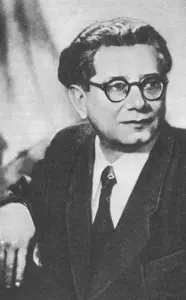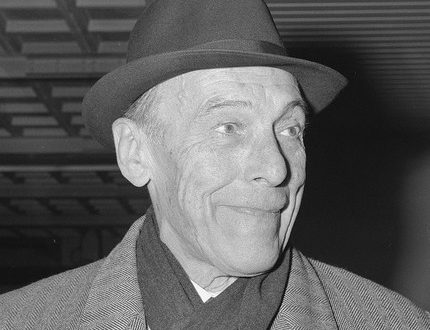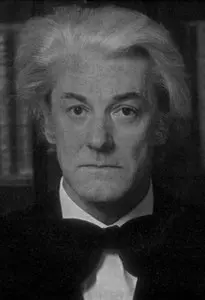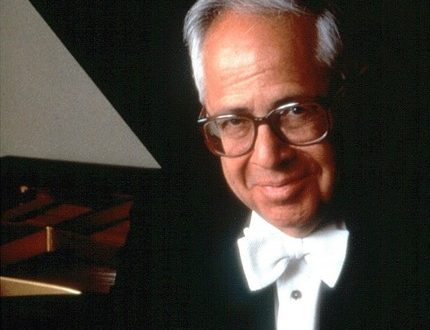
Grigory Romanovich Ginzburg |
Grigory Ginzburg

Grigory Romanovich Ginzburg came to the Soviet performing arts in the early twenties. He came at a time when such musicians as K. N. Igumnov, A. B. Goldenweiser, G. G. Neuhaus, S. E. Feinberg were intensively giving concerts. V. Sofronitsky, M. Yudina stood at the origins of their artistic path. A few more years will pass – and the news of the victories of musical youth from the USSR in Warsaw, Vienna and Brussels will sweep the world; people will name Lev Oborin, Emil Gilels, Yakov Flier, Yakov Zak and their peers. Only a really great talent, a bright creative individuality, could not fade into the background in this brilliant constellation of names, not lose the right to public attention. It happened that performers who were by no means untalented retreated into the shadows.
This did not happen with Grigory Ginzburg. Until the last days he remained equal among the first in Soviet pianism.
Once, while talking with one of the interviewers, Ginzburg recalled his childhood: “My biography is very simple. There was not a single person in our family who would sing or play any instrument. My parents’ family was the first to manage to acquire an instrument (piano.— Mr. C.) and began to somehow introduce children to the world of music. So we, all three brothers, became musicians.” (Ginzburg G. Conversations with A. Vitsinsky. S. 70.).
Further, Grigory Romanovich said that his musical abilities were first noticed when he was about six years old. In the city of his parents, Nizhny Novgorod, there were not enough authoritative specialists in piano pedagogy, and he was shown to the famous Moscow professor Alexander Borisovich Goldenweiser. This decided the fate of the boy: he ended up in Moscow, in the house of Goldenweiser, at first as a pupil and student, later – almost an adopted son.
Teaching with Goldenweiser was not easy at first. “Alexander Borisovich worked with me carefully and very demandingly … Sometimes it was difficult for me. One day, he got angry and threw all my notebooks right out into the street from the fifth floor, and I had to run downstairs after them. It was in the summer of 1917. However, these classes gave me a lot, I remember for the rest of my life ” (Ginzburg G. Conversations with A. Vitsinsky. S. 72.).
The time will come, and Ginzburg will become famous as one of the most “technical” Soviet pianists; this will have to be revisited. For now, it should be noted that he laid the foundation for performing arts from an early age, and that the role of the chief architect, who supervised the construction of this foundation, who managed to give it granite inviolability and hardness, is exceptionally great. “… Alexander Borisovich gave me absolutely fantastic technical training. He managed to bring my work on technique with his characteristic perseverance and method to the most possible limit … ” (Ginzburg G. Conversations with A. Vitsinsky. S. 72.).
Of course, the lessons of a generally recognized erudite in music, like Goldenweiser, were not limited to work on technique, craft. Moreover, they were not reduced to just one piano playing. There was also time for musical-theoretical disciplines, and – Ginzburg spoke about this with particular pleasure – for regular sight reading (many four-hand arrangements of works by Haydn, Mozart, Beethoven, and other authors were replayed in this way). Alexander Borisovich also followed the general artistic development of his pet: he introduced him to literature and theater, brought up the desire for a breadth of views in art. The Goldenweisers’ house was often visited by guests; among them one could see Rachmaninov, Scriabin, Medtner, and many other representatives of the creative intelligentsia of those years. The climate for the young musician was extremely life-giving and beneficial; he had every reason to say in the future that he was truly “lucky” as a child.
In 1917, Ginzburg entered the Moscow Conservatory, graduated from it in 1924 (the young man’s name was entered on the marble Board of Honor); in 1928 his graduate studies came to an end. A year earlier, one of the central, one might say, culminating events in his artistic life took place – the Chopin Competition in Warsaw.
Ginzburg took part in the competition together with a group of his compatriots – L. N. Oborin, D. D. Shostakovich and Yu. V. Bryushkov. According to the results of competitive auditions, he was awarded the fourth prize (an outstanding achievement according to the criteria of those years and that competition); Oborin won first place, Shostakovich and Bryushkov were awarded honorary diplomas. The game of the pupil of Goldenweiser was a great success with the Varsovians. Oborin, upon his return to Moscow, spoke in the press about the “triumph” of his comrade, “about the continuous applause” that accompanied his appearances on the stage. Having become a laureate, Ginzburg made, like a lap of honor, a tour of the cities of Poland – the first foreign tour in his life. Some time later, he once again visited the happy Polish stage for him.
As for Ginzburg’s acquaintance with the Soviet audience, it took place long before the events described. While still a student, in 1922 he played with Persimfans (Persimfans – The First Symphony Ensemble. An orchestra without a conductor, which regularly and successfully performed in Moscow in 1922-1932) Liszt’s concerto in E-flat major. A year or two later, his touring activity, which was not too intense at first, begins. (“When I graduated from the conservatory in 1924,” recalled Grigory Romanovich, “there was almost nowhere to play except for two concerts a season in the Small Hall. They weren’t particularly invited to the provinces. Administrators were afraid to take risks. There was no Philharmonic Society yet …”)
Despite infrequent meetings with the public, Ginzburg’s name is gradually gaining popularity. Judging by the surviving evidence of the past – memoirs, old newspaper clippings – it is gaining popularity even before the pianist’s Warsaw successes. Listeners are impressed by his game – strong, precise, confident; in the responses of the reviewers one can easily recognize admiration for the “powerful, all-destroying” virtuosity of the debuting artist, who, regardless of age, is “an outstanding figure on the Moscow concert stage”. At the same time, its shortcomings are not concealed either: a passion for excessively fast tempos, excessively loud sonorities, conspicuous, hitting the effect with finger “kunshtuk”.
Criticism grasped mainly what was on the surface, judged by external signs: pace, sound, technology, playing techniques. The pianist himself saw the main thing and the main thing. By the mid-twenties, he suddenly realized that he had entered a period of crisis – a deep, protracted one, which entailed unusually bitter reflections and experiences for him. “… By the end of the conservatory, I was completely confident in myself, confident in my unlimited possibilities, and literally a year later I suddenly felt that I couldn’t do anything – it was a terrible period … Suddenly, I looked at my game with someone else’s eyes, and terrible narcissism turned into complete self dissatisfaction” (Ginzburg G. Conversation with A. Vitsinsky. S. 76.).
Later, he figured it all out. It became clear to him that the crisis marked a transitional stage, his adolescence in piano performance was over, and the apprentice had time to enter the category of masters. Subsequently, he had occasions to make sure – on the example of his colleagues, and then his students – that the time of artistic mutation does not proceed secretly, imperceptibly and painlessly for everyone. He learns that the “hoarseness” of the stage voice at this time is almost inevitable; that feelings of internal disharmony, dissatisfaction, discord with oneself are quite natural. Then, in the twenties, Ginzburg was only aware that “it was a terrible period.”
It would seem that quite a long time ago it was so easy for him: he assimilated the text of the work, learned the notes by heart – and everything further came out by itself. Natural musicality, pop “instinct”, caring care of the teacher – this removed a fair amount of troubles and difficulties. It was filmed – now it turned out – for an exemplary student of the conservatory, but not for a concert performer.
He managed to overcome his difficulties. The time has come and reason, understanding, creative thought, which, according to him, he lacked so much on the threshold of independent activity, began to determine a lot in the pianist’s art. But let’s not get ahead of ourselves.
The crisis lasted for about two years – long months of wandering, searching, doubting, thinking … Only by the time of the Chopin Competition, Ginzburg could say that the hard times had largely been left behind. He again stepped onto an even track, gained firmness and stability of step, decided for himself – that him to play and as.
It is worth noting that the first that playing had always seemed to him a matter of exceptional importance. Ginzburg did not recognize (in relation to himself, in any case) repertoire “omnivorousness”. Disagreeing with fashionable views, he believed that a performing musician, like a dramatic actor, should have his own role – creative styles, trends, composers, and plays close to him. At first, the young concert player was fond of romance, especially Liszt. Brilliant, pompous, dressed in luxurious pianistic robes Liszt – the author of “Don Giovanni”, “The Marriage of Figaro”, “Dance of Death”, “Campanella”, “Spanish Rhapsody”; these compositions constituted the golden fund of Ginzburg’s pre-war programs. (The artist will come to another Liszt – a dreamy lyricist, poet, creator of Forgotten Waltzes and Gray Clouds, but later.) Everything in the works named above was in tune with the nature of Ginzburg’s performance in the post-conservatory period. Playing them, he was in a truly native element: in all its glory, it manifested itself here, sparkling and sparkling, his amazing virtuoso gift. In his youth, Liszt’s playbill was often framed by such plays as Chopin’s A-flat major polonaise, Balakirev’s Islamey, the famous Brahmsian variations on a theme of Paganini – the music of a spectacular stage gesture, a brilliant multicolor of colors, a kind of pianistic “Empire”.
Over time, the pianist’s repertoire attachments changed. Feelings for some authors cooled down, a passion for others arose. Love came to the musical classics; Ginzburg will remain faithful to her until the end of his days. With full conviction he once said, talking about Mozart and Beethoven of the early and middle periods: “This is the real sphere of application of my forces, this is what I can and know most of all” (Ginzburg G. Conversations with A. Vitsinsky. S. 78.).
Ginzburg could have said the same words about Russian music. He played it willingly and often – everything from Glinka for the piano, much from Arensky, Scriabin and, of course, Tchaikovsky (the pianist himself considered his “Lullaby” among his greatest interpreting successes and was quite proud of it).
Ginzburg’s paths to modern musical art were not easy. It is curious that even in the mid-forties, almost two decades after the beginning of his extensive concert practice, there was not a single line of Prokofiev among his performances on the stage. Later, however, both Prokofiev’s music and piano opuses by Shostakovich appeared in his repertoire; both authors took a place among his most beloved and revered. (Isn’t it symbolic: among the last works the pianist learned in his life was Shostakovich’s Second Sonata; the program of one of his last public performances included a selection of preludes by the same composer.) One more thing is also interesting. Unlike many contemporary pianists, Ginzburg did not neglect the genre of piano transcription. He constantly played transcriptions – both others’ and his own; made concert adaptations of works by Punyani, Rossini, Liszt, Grieg, Ruzhitsky.
The composition and nature of the pieces offered by the pianist to the public changed – his manner, style, creative face changed. So, for example, not a trace was soon left of his youthful flaunting of technicalism, virtuoso rhetoric. Already by the beginning of the thirties, criticism made a very significant observation: “Speaking like a virtuoso, he (Ginzburg.— Mr. C.) thinks like a musician” (Kogan G. Issues of pianism. – M., 1968. P. 367.). The artist’s playing handwriting is becoming more and more definite and independent, pianism is becoming mature and, most importantly, individually characteristic. The distinctive features of this pianism are gradually grouped at the pole, diametrically opposed to the pressure of power, all sorts of expressive exaggerations, the performing “Sturm und Drang”. Specialists who watched the artist in the prewar years state: “Unbridled impulses,“ noisy bravura ”, sound orgies, pedal“ clouds and clouds ”are by no means his element. Not in fortissimo, but in pianissimo, not in a riot of colors, but in the plasticity of the drawing, not in brioso, but in leggiero – Ginzburg’s main strength” (Kogan G. Issues of pianism. – M., 1968. P. 368.).
The crystallization of the appearance of the pianist comes to an end in the forties and fifties. Many still remember Ginzburg of those times: an intelligent, comprehensively erudite musician who convinced with logic and strict evidence of his concepts, enchanted with his elegant taste, some special purity and transparency of his performing style. (Earlier, his attraction to Mozart, Beethoven was mentioned; presumably, it was not accidental, as it reflected some typological properties of this artistic nature.) Indeed, the classical coloring of Ginzburg’s playing is clear, harmonious, internally disciplined, balanced in general and particulars – perhaps the most noticeable feature of the pianist’s creative manner. Here is what distinguishes his art, his performing speech from the impulsive musical statements of Sofronitsky, the romantic explosiveness of Neuhaus, the soft and sincere poetics of the young Oborin, the piano monumentalism of Gilels, the affected recitation of Flier.
Once he was acutely aware of the lack of “reinforcement”, as he said, performing intuition, intuition. He came to what he was looking for. The time is coming when Ginzburg’s magnificent (there is no other word for it) artistic “ratio” declares itself at the top of its voice. Whatever author he turned to in his mature years – Bach or Shostakovich, Mozart or Liszt, Beethoven or Chopin – in his game one could always feel the primacy of a detailed thought-out interpretive idea, cut in the mind. Random, spontaneous, not formed into a clear performance intention – there was practically no place for all this in Ginzburg’s interpretations. Hence – the poetic accuracy and accuracy of the latter, their high artistic correctness, meaningful objectivity. “It is difficult to give up the idea that the imagination sometimes immediately precedes the emotional impulse here, as if the pianist’s consciousness, having first created an artistic image, then evoked the corresponding musical sensation” (Rabinovich D. Portraits of pianists. – M., 1962. P. 125.), — critics shared their impressions of the pianist’s playing.
Ginzburg’s artistic and intellectual beginning cast its reflection on all links of the creative process. It is characteristic, for example, that a significant part of the work on the musical image was done by him directly “in his mind”, and not at the keyboard. (As you know, the same principle was often used in the classes of Busoni, Hoffmann, Gieseking and some other masters who mastered the so-called “psychotechnical” method.) “… He (Ginzburg.— Mr. C.), sat in an armchair in a comfortable and calm position and, closing his eyes, “played” each work from beginning to end at a slow pace, evoking in his presentation with absolute accuracy all the details of the text, the sounding of each note and the entire musical fabric as a whole. He always alternated playing the instrument with mental verification and improvement of the pieces he had learned. (Nikolaev A. G. R. Ginzburg / / Questions of piano performance. – M., 1968. Issue 2. P. 179.). After such work, according to Ginzburg, the interpreted play began to emerge in his mind with maximum clarity and distinctness. You can add: in the minds of not only the artist, but also the public who attended his concerts.
From the warehouse of Ginzburg’s game thinking – and a somewhat special emotional coloring of his performance: restrained, strict, at times as if “muffled”. The art of the pianist has never exploded with bright flashes of passion; there was talk, it happened, of his emotional “insufficiency.” It was hardly fair (worst minutes do not count, everyone can have them) – with all the laconicism, and even the secrecy of emotional manifestations, the musician’s feelings were meaningful and interesting in their own way.
“It always seemed to me that Ginzburg was a secret lyricist, embarrassed to keep his soul wide open,” one of the reviewers once remarked to the pianist. There is a lot of truth in these words. Ginzburg’s gramophone records have survived; they are highly valued by philophonists and music lovers. (The pianist recorded Chopin’s impromptu, Scriabin’s etudes, transcriptions of Schubert’s songs, sonatas by Mozart and Grieg, Medtner and Prokofiev, plays by Weber, Schumann, Liszt, Tchaikovsky, Myaskovsky and much more.); even from these discs – unreliable witnesses, which missed a lot in their time – one can guess the subtlety, almost shyness of the artist’s lyrical intonation. Guessed, despite the lack of special sociability or “intimacy” in her. There is a French proverb: you don’t have to tear your chest open to show that you have a heart. Most likely, Ginzburg the artist reasoned in much the same way.
Contemporaries unanimously noted the exceptionally high professional pianistic class of Ginzburg, his unique performing skill. (We have already discussed how much he owes in this regard not only to nature and diligence, but also to A. B. Goldenweiser). Few of his colleagues managed to reveal the expressive and technical possibilities of the piano with such exhaustive completeness as he did; few people knew and understood, as he did, the “soul” of his instrument. He was called “a poet of pianistic skill”, admired the “magic” of his technique. Indeed, the perfection, the impeccable completeness of what Ginzburg did at the piano keyboard, singled him out even among the most famous concert players. Unless a few could compare with him in the openwork chasing of passage ornamentation, the lightness and elegance of the performance of chords or octaves, the beautiful roundness of phrasing, the jewelery sharpness of all elements and particulars of the piano texture. (“His playing,” contemporaries wrote admiringly, “reminiscent of fine lace, where skillful and intelligent hands carefully woven every detail of an elegant pattern – every knot, every loop.”) It would not be an exaggeration to say that the amazing pianistic skill – one of the most striking and attractive features in the portrait of a musician.
Sometimes, no, no, yes, and the opinion was expressed that the merits of Ginzburg’s playing can be attributed for the most part to the external in pianism, to the sound form. This, of course, was not without some simplification. It is known that form and content in the musical performing arts are not identical; but the organic, indissoluble unity is unconditional. One here penetrates the other, intertwines with it by innumerable inner ties. That is why G. G. Neuhaus wrote in his time that in pianism it can be “difficult to draw a precise line between work on technique and work on music…”, because “any improvement in technique is an improvement in the art itself, which means it helps to identify the content, “hidden meaning…” (Neigauz G. On the art of piano playing. – M., 1958. P. 7. Note that a number of other artists, not only pianists, argue in a similar way. The famous conductor F. Weingartner said: “Beautiful form inseparable from living art (my detente. – G. Ts.). And precisely because it feeds on the spirit of art itself, it can convey this spirit to the world ”(quoted from the book: Conductor Performance. M., 1975. P. 176).).
Ginzburg the teacher did a lot of interesting and useful things in his time. Among his students at the Moscow Conservatory one could see subsequently notorious figures of Soviet musical culture – S. Dorensky, G. Axelrod, A. Skavronsky, A. Nikolaev, I. Ilyin, I. Chernyshov, M. Pollak … All of them gratefully recalled later the school that they went through under the guidance of a wonderful musician.
Ginzburg, according to them, instilled in his students a high professional culture. He taught harmony and the strict order that reigned in his own art.
Following A. B. Goldenweiser and following his example, he in every possible way contributed to the development of broad and multilateral interests among young students. And of course, he was a great master of learning to play the piano: having a huge stage experience, he also had a happy gift to share it with others. (Ginsburg the teacher will be discussed later, in an essay dedicated to one of his best pupils, S. Dorensky.).
Ginzburg enjoyed high prestige among his colleagues during his lifetime, his name was pronounced with respect by both professionals and competent music lovers. And yet, the pianist, perhaps, did not have the recognition that he had the right to count on. When he died, voices were heard that he, they say, was not fully appreciated by his contemporaries. Perhaps… From a historical distance, the place and role of the artist in the past are more accurately determined: after all, the big “one cannot see face to face”, it is seen from a distance.
Shortly before the death of Grigory Ginzburg, one of the foreign newspapers called him “the great master of the older generation of Soviet pianists.” Once upon a time, such statements, perhaps, were not given much value. Today, decades later, things are different.
G. Tsypin





